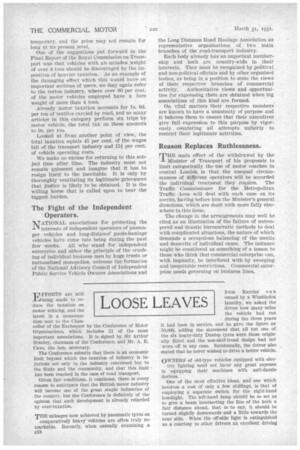LOOSE LEAVES
Page 40

Page 41

If you've noticed an error in this article please click here to report it so we can fix it.
EFFORTS are still .11-lbeing made to reduce the taxation on motor vehicles, and the latest is a memorandum sent to the Chancellor of the Exchequer by the Conference of Motor Organizations, which includes 21 of the most important associations. It is signed by Sir Arthur Stanley, chairman of the Conference, and Mr. A. E. Cave, the hon. secretary.'
The Conference submits that there is an economic limit beyond which the taxation of industry is injurious not only to the industry concerned but to the State and the community, and that this limit has been reached in the case of road transport.
Given fair conditions, it continues, there is every reason to anticipate that the British motor industry will become one of the great staple industries of the country, but the Conference is definitely of the opinion that such development is already retarded by over-taxation.
THE mileages now achieved by pneumatic tyres on comparatively heavy' vehicles are often truly remarkable. Recently, when casually examining a 34011 Karrier v a n owned by a Wimbledon laundry, we asked the driver how many miles the vehicle had run during the three years it had been in service, and he gave the figure as 50,000, adding the statement that all but one of the six heavy-duty Dunlop tyres were those originally fitted and the non-skid-tread design had not worn off in any ease. Incidentally, the driver also stated that he never wished to drive a better vehicle.
OWNERS of old-type vehicles equipped with electric lighting need not incur any great expense in equipping their machines with anti-dazzle devices.
One of the most effective ideas, and one which involves a cost of only a few shillings, is that of employing a separate switch for the right-hand headlight. The left-hand lamp should be so set as to give a beam intersecting the line of the kerb a fair distance ahead, that is to say, it should be turned slightly downwards and a little towards the near side. When the off-side light is extinguished as a courtesy to other drivers an excellent driving beam is still obtained, thus there is no risk involved, as would be the case if both lamps were switched off altogether, and the change of light is not too great to permit rapid readjustment of the driver's vision.
IN a speech made recently at the annual dinner of the Drapers' Chamber of Trade, Mr. Herbert Morrison gave some interesting statistics regarding the condition of trade.
• He mentioned that whilst industrial activity in the United Kingdom in 1930 was 7.6 per cent. lower than in 1929, and 2.1 per cent. lower than in 1928, it was actually 3.3 per cent, higher than in 1924.
The index of production for the year showed a decrease of .8 per cent.as compared with that for the previous year. This compares with a figure of 25 per cent. for the corresponding period in the case of the United States, and 20.5 per cent. for Germany, so that the general depression has not hit this country to the same extent as it has the other two mentioned.
AN interesting situation in motorbus traffic in the north of England is dealt with this week in our feature "Operating Aspects of Passenger Trans port." Big operating companies are seeking •to withdraw a bus service which is worked by them jointly, their justification being that adequate railway facilities exist between the two points. Needless to say, they are companies in which there is a railway interest. , This, surely, provides food for thought.












































































































